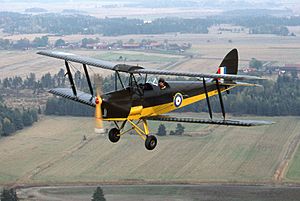Operation Banquet facts for kids
Quick facts for kids Operation Banquet |
|
|---|---|

de Havilland DH 82A Tiger Moth, N81DH
|
|
| Planned | 1940–1941 |
| Planned by | |
| Objective | Air Defence of Great Britain |
| Executed by | Royal Air Force |
| Outcome | Cancelled |
Operation Banquet was a secret British plan during World War II. It was created to defend Great Britain if Germany tried to invade in 1940 or 1941. After France was taken over by Germany in June 1940, Britain quickly prepared for a possible invasion.
At the same time, the Royal Air Force (RAF) was fighting the German Luftwaffe (air force) in the Battle of Britain. The British government realized they might need every single airplane they had. This included even training planes, to fight off an invasion.
Contents
The Main Plan
In July 1940, the RAF was ordered to make a plan to use as many aircraft as possible. This plan was called Operation Banquet. It had different parts that could be used on their own.
- Banquet 6 Group: This part would use planes from RAF Bomber Command's training units. These planes would join the main bomber squadrons.
- Banquet 22 Group: This involved moving some planes from No. 22 Group RAF (which worked with the army) to regular bomber squadrons.
- Banquet Alert: This was a more desperate plan. It would use training planes from the Fleet Air Arm (the navy's air force) under Coastal Command.
- Banquet Training: This part would take planes from RAF Training Command and add them to the main bomber force.
Many of these planes were not ready for battle. They often lacked special equipment like bombsights (to aim bombs), armor, guns, or self-sealing fuel tanks (to stop fuel leaks). However, the RAF said that any plane that could fly and drop bombs should be used.
How Many Planes Were Ready?
By early July, about 1,000 aircraft were ready for anti-invasion operations. These planes ranged from small De Havilland Tiger Moth trainers to large Vickers Wellington bombers. The goal was to have another 1,000 planes ready later.
Using slow planes for ground attacks was not a new idea. Other countries had done it successfully. These slow, easy-to-maneuver planes could attack enemy troops on the ground accurately. They could also escape before the enemy set up strong air defenses.
Ground crews, and sometimes even civilian volunteers, would go with their planes. The pilots for the "Banquet Alert" and "Training" parts would be experienced instructors. Some students who were good enough would also fly.
Where Would the Planes Go?
Most training schools were not close to where an invasion might happen. Moving them during an invasion would be difficult. Closer airfields would likely be bombed and busy with regular squadrons.
So, it was decided to send small groups of 5–6 basic trainer planes to different bases. These bases belonged to Army Cooperation, Coastal, and Bomber commands. The main effort would still come from the regular Bomber Command squadrons.
The decision of when to start Operation Banquet was kept flexible. If Germany landed in a surprising place, like Scotland, the plan would start right away. But if they landed where expected, the planes would be used as a last resort. This would depend on how quickly the battle got worse.
Banquet Light: Tiger Moths as Bombers
One special part of the plan was Banquet Light. This involved using De Havilland Tiger Moth biplanes and other small aircraft from flying schools. The Tiger Moth was a small, two-seater training plane.
De Havilland, the company that made the Tiger Moth, designed a way to turn it into a bomber. They added eight small bomb racks under the plane. These racks could hold 20 lb (9 kg) bombs. Tests showed that the modified Tiger Moths worked well. They even tested a Tiger Moth carrying a 240 lb (109 kg) bomb!
The Banquet Light planes would help the army. They would bomb groups of enemy paratroopers or soldiers landing on beaches. The two-seater Tiger Moth bombers would fly with just one pilot. They would fly low to find the enemy, then climb to 800 feet (240 m), dive to 500 feet (150 m), and drop their bombs.
Training for Young Pilots
Most pilots for Banquet Light would be students who had not yet finished their training. The plan required that trainee pilots learn about bombing early in their instruction. This was in case they needed to fight right away.
Instructors were told to practice bombing whenever they could. In early 1940, there were no practice bombs. So, instructors would fly the plane from the front seat. Students in the back seat would throw house bricks out of the plane! They soon learned that bricks fell slower than the diving plane. So, they were told to throw the bricks forcefully away from the aircraft.
There was also an idea to use civilian planes for Banquet Civil, but this plan was later dropped.
Cancellation
Operation Banquet was never actually put into action. However, it was practiced sometimes under different names. One such "exercise" secretly helped with the first 1,000 bomber raid on the city of Cologne. This huge raid happened on the night of May 30/31, 1942. It needed many bombers from Coastal Command and Training Command.
Operation Banquet was officially cancelled in October 1943.
See also

